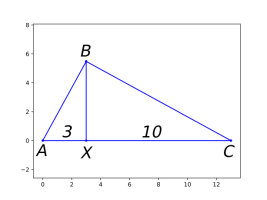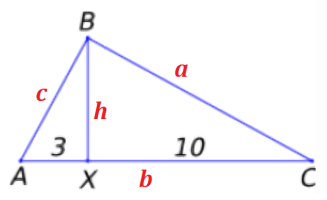I just can't solve this one. I tried everything. None of the identities worked because there seems to be missing information.
Given: A triangle ABC from left to right, clockwise. Angles A and C are unknown, but angle B = 90. Sides a-b and b-c are also unknown. But from apex B a line is drawn straight down to point x at the base a-c. This vertical line b-x is perpendicular to base a-c. Thus the triangle is cut in half and form two right triangles within the larger right triangle. The length of a-x = 3. The length of x-c = 10. So, side a-c = 3 + 10 = 13. None of the others sides are known. Find the height of b-x. The answer choices are: a) 30 b) sqrt (30) c) 13 d) sqrt (109). Thanks for your help
Given: A triangle ABC from left to right, clockwise. Angles A and C are unknown, but angle B = 90. Sides a-b and b-c are also unknown. But from apex B a line is drawn straight down to point x at the base a-c. This vertical line b-x is perpendicular to base a-c. Thus the triangle is cut in half and form two right triangles within the larger right triangle. The length of a-x = 3. The length of x-c = 10. So, side a-c = 3 + 10 = 13. None of the others sides are known. Find the height of b-x. The answer choices are: a) 30 b) sqrt (30) c) 13 d) sqrt (109). Thanks for your help


